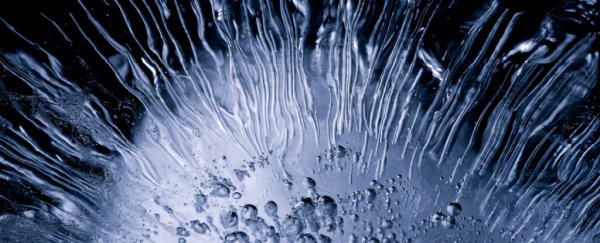States of matter describe the distinct ways certain groups of particles arrange themselves with various temperatures and forces.
Historically, these descriptions have focussed on a material's shape and volume, giving us just three traditional states: solid, liquid, and gas.
What is a solid?
Solid states describe materials at a fairly fixed volume and shape, for example, with particles bound in a highly ordered (if it's a crystal, like diamond) or relatively disordered (if it's an amorphous solid, like glass) configuration.
What is a liquid?
Liquid states describe materials of a relatively constant volume, but with shapes that conform more easily to a container when pulled by gravity.
Forces connecting their particles allow for a greater degree of movement than in solids, allowing them to flow.
What is a gas?
Gaseous states describe materials that have no fixed volume, with shapes determined by the edges of their containers or surrounding forces. Forces between their particles allow for a large amount of random motion over a wide area.
Modifying the amount of energy in a material or changing external forces such as by raising the pressure or temperature affects the movements of particles with respect to the forces binding them together.
Adding temperature can turn a solid into a liquid, for example. Applying enough pressure to a gas, on the other hand, could force particles close enough to form a liquid state in a state change referred to as condensation.
What is sublimation?
When a solid directly enters a gaseous state without first becoming a liquid, it's called sublimation. This occurs at pressures or temperatures below a substance's triple point - the temperature and pressure at which all three states of that substance coexist in equilibrium.
How many states of matter are there?
Depending on the kinds of properties used to define states, there could be dozens of different examples found in mundane and extreme environments throughout the Universe.
Properties such as conductivity and even characteristics of a quantum nature have come to define new kinds of states, including plasma and Bose-Einstein condensates.
What is plasma?
Plasmas, for example, are similar to gases in that their particles have no fixed shape or volume, with particles zipping far and wide with huge amounts of energy.
Unlike traditional gases, the particles making up plasmas are reduced to charged forms, with the negatively charged electrons being pulled away and leaving positively charged nuclei.
At even higher temperatures the fundamental particles making up the nuclei of atoms - quarks and force particles called gluons - can find it hard to stick together, forming what's known as a quark-gluon soup. It's believed that this state of matter was most common in the hot, dense conditions of the Universe in its infancy.
What is a Bose-Einstein condensate?
A Bose-Einstein condensate occurs when the temperature of certain materials is reduced far enough for energetic movement to all but stop. With such little motion, the quantum properties of each particle in the material is shared, giving the 'cloud' a single identity.
What's the difference between a matter's phase and its state?
While the terms phase of matter and state of matter are sometimes used in place of one another, there is a difference.
Where a state of matter describes properties such as volume and shape of a material, a phase of matter describes the similarity of properties of particles within a certain region of space.
Picture two containers, each containing an ice cube. The water in each is in the same state (solid), and each container shares the same phase (water in solid form).
If we melt one ice cube, the states will be different (liquid and solid), as will the phases (liquid and solid phases of water).
If we swap an ice cube with a block of iron, the states will be the same (solid water and solid iron), but the phases inside each container will be defined by different densities, magnetism, and reflectivity.
All Explainers are determined by fact checkers to be correct and relevant at the time of publishing. Text and images may be altered, removed, or added to as an editorial decision to keep information current.
